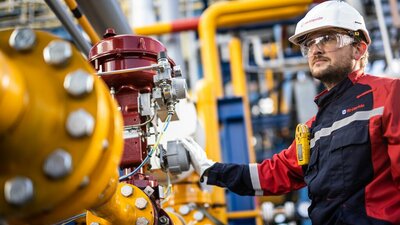Hydrogen mobility for heavy-duty: Air Liquide and Faurecia are on the case!
Published on September 06, 2022
5 minutes

Faced with the challenges of climate change, low-carbon hydrogen represents an essential building block in the energy transition. This conviction, shared by both Air Liquide and Faurecia, a company of the FORVIA Group, is a driving force of their partnership to develop and produce a more efficient solution for long-distance heavy-duty vehicles: a propulsion system powered by liquid hydrogen stored on board.
The driving force behind the Air Liquide & Faurecia partnership
It all started with a shared conviction: liquid hydrogen is an effective solution to decarbonize heavy-duty transportation (trucks), which accounts for 6% of CO2 emissions worldwide1. However, manufacturers must accomplish their energy transitions without sacrificing economic imperatives and the user experience. They need their vehicles to continue to meet certain industry requirements, including long ranges, route flexibility and large payloads. The solution? Bring hydrogen - nearly 80 kg of it - on board.

“The arrival of this energy carrier is a small revolution in mobility. Our expertise in hydrogen cryogenics and its value chain makes us a natural ally that can help Faurecia offer a credible solution to heavy-duty vehicle manufacturers.
”
Éric Prades
Director of Energy Transition Partnerships, Hydrogen Energy business line, Air Liquide
Overcoming the challenges of a low-carbon energy carrier
This partnership between Air Liquide and Faurecia aims to bring concrete solutions to heavy-duty vehicle manufacturers and operators. Although liquid hydrogen has been around for more than 60 years, its use was reserved for specific high-tech applications such as space propulsion through the early 2010s.
In addition to making a drastic change in scale, the teams must take on a technological challenge: designing onboard tanks for extensive use that can then be mass-produced while maintaining economic viability. This is where Air Liquide and Faurecia come in. The former is a world expert in hydrogen production and liquefaction techniques and extreme cryogenics processes, the latter a global leader in automotive zero emission mobility with recognized expertise in technology integration in vehicles of all sizes. "Liquid hydrogen is an energy carrier that perfectly meets the needs of heavy-duty transportation," notes Éric Prades, Director of Energy Transition Partnerships, Hydrogen Energy business line, at Air Liquide. "Our expertise in hydrogen cryogenics and its entire value chain makes us a natural ally that can help Faurecia offer a credible low-carbon solution to heavy-duty vehicle manufacturers and operators."
Making the switch to liquid hydrogen for numerous transportation sectors

“Along with Air Liquide, Faurecia is looking to add liquid hydrogen to its portfolio of hydrogen storage solutions, which will increase the range of heavy-duty vehicles while maintaining flexibility.
”
Pauline Chartier
Director of Strategy and Partnerships at Faurecia
From pilot to market: a team acting on all fronts
The partnership between Air Liquide and Faurecia dates back to October 2021. It consists of a joint team, with each company bringing their respective skills in order to take on this technological feat: storage systems, vehicle integration and scale-up (Faurecia), and hydrogen production, cryogenics and supply chain logistics (Air Liquide). The team has already completed a technological and economic feasibility study with extremely promising results on both fronts. Currently in the prototyping phase, the product is set to hit the market in 2027. By that time, the solution must be able to attract and win over vehicle manufacturers. This means that both companies need to overcome the challenges essential to the project’s success, including standardizing the dedicated supply chain (stations, connectors, tanks, etc.) and scaling up a highly complicated technology (creating and maintaining a vacuum in the tanks, initiating large-scale production). The project team is tackling these challenges on a daily basis, while ensuring compliance with standards and regulations and keeping the operator safe, issues which both groups are heavily involved in.
The targets are ambitious: with these building blocks in the assembly phase, the partnership aims to produce and market tens of thousands of tanks and install them in vehicles by 2030. In the long term, the conversion rate needs to have a sufficiently large impact in order to actively contribute to low-carbon objectives in France, as well as in Europe and the world. In 2050, 50% of zero-emission heavy-duty vehicles should run on hydrogen.
Learn more about the technology in our second installment





